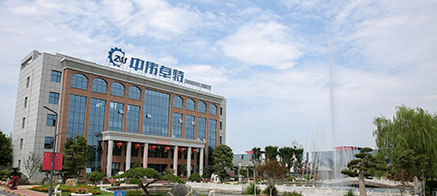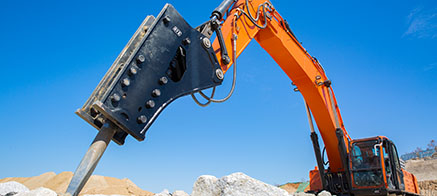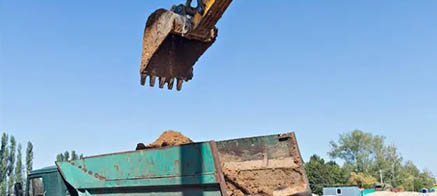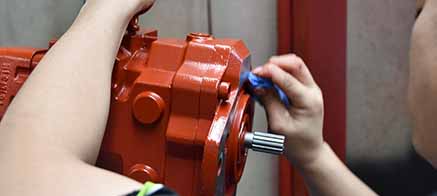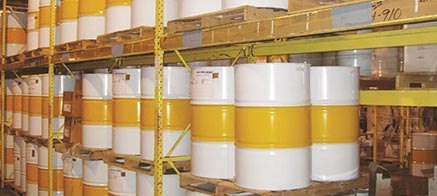Seven solutions for mini excavator holding the car
I. Air filtration and clogging Clogged air filter will lead to poor air intake, because the increase of frictional resistance will reduce the total gas flow, resulting in insufficient engine drive. Therefore, the mini excavator should immediately clean the air filter of the diesel engine or remove the dust on the paper filter, and replace the filter in serious cases. Second, the exhaust pipe is blocked And the air filter is clogged, in turn the clogging of the exhaust pipe will lead to poor air outlet. The higher the specific oxygen content of carbon dioxide, the lower the efficiency of gasoline and diesel fuel, and the output of working capacity will be reduced. So, usually, we should also check the carbon in the exhaust pipe and remove it on time to make the intake and exhaust pipes clear. III. Non-compliance management of oil supply advance angle Too large or too small supply advance angle will lead to unstable pumping time of gasoline pump, and it is impossible to ignite to output full mechanical energy. If you find that the angle of oil supply angle provided is not in compliance, you need to check whether the tightening head screw of the oil pump swivel is loose; if it is loose, check the angle of advance again and tighten the screw. IV. Piston rod and cylinder liner damage Due to the piston rod and cylinder liner parts bruised or damaged seriously, increasing the transmission loss of driving force in the whole process, reducing the mechanical energy output, leading to damage and improvement of the mechanical equipment itself to the car engine. At this time, the piston rod, cylinder liner and engine piston should be removed and replaced, and more attention should be paid to this component in daily work. V. Diesel system abnormalities 1. The gas entering the gasoline filter or pipeline not only endangers the quality of gasoline and diesel fuel, but also leads to poor oil circuit and difficulty in ignition. In this case, the gas in the pipeline should be excluded and the air filter should be cleared. 2. Damaged oil pump parts lead to small ignition advance angle, oil leakage and poor atomization, which are very likely to cause cylinder shortage. When such common failures are found, the parts must be cleaned and the damaged parts replaced. 3. Insufficient oil provided by the diesel pump will also lead to low engine displacement. In this case, again adjust the oil provided by the diesel pump, or check, repair and replace parts. Six, lubrication and cooling system abnormalities Abnormal intake system or cooling system will cause high temperature and oil temperature, which will easily lead to diesel engine combustion, and then lead to common failures such as piston rod position jamming. Therefore, when the diesel engine is hot, the lubrication and refrigeration system, including the cooling tower and heat pipe radiator, should be inspected to remove scale, maintained or replaced. VII. Common faults of cylinder head assembly 1. Due to the exhaust pipe leakage, organic exhaust gas enters resulting in low air volume or low air index, resulting in inadequate gas and diesel ignition, which not only consumes a lot of oil, but also causes incomplete mechanical energy conversion. At this time, check the cylinder and the cylinder seat mating surface, or replace the new parts to improve its air tightness. 2. cylinder head and the whole body of the tight connection is not tight, very easy to cause external steam into the water or main oil circuit, or cooling circulating water into the car engine interior. If not found immediately, it will cause "slippage" or exhaust pipe black smoke, so that the car engine drive power is not enough. Therefore, at this time should be careful to tighten the screws or replace the cylinder head. 3. Valve is too large or cylinder torsion spring brittle easily cause cylinder leakage, natural gas will reduce the gas-diesel ignition is not sufficient, reduce engine displacement. Therefore, it is necessary to check the cylinder position or replace the fragile cylinder torsion spring. 4. Injection pump mounting hole leakage or copper gasket damage will lead to the lack of cylinders and driving force of the car engine. It should be removed for maintenance and the damaged parts should be replaced. If the seepage temperature is too low, it will lead to the expansion of the exhaust heat damage. In this case, the temperature should be adjusted has reached the required standard value. In fact, the cause of mini excavator truck can be summarized as two reasons:The air inlet and outlet is not smooth. Check each part from two levels of the air inlet and air outlet of the car engine, and differentiate according to whether the sound of each part is normal or not. Naturally, the most important thing is the routine cleaning, maintenance and replacement of the parts. Each component is physically and mentally healthy. Of course, your car engine will be full of driving force.










